
Sir Robert Harley was an English statesman who served as Master of the Mint for Charles I. A devout Puritan, he supported Parliament in the Wars of the Three Kingdoms.

Wimpole Estate is a large estate containing Wimpole Hall, a country house located within the civil parish of Wimpole, Cambridgeshire, England, about 8+1⁄2 miles southwest of Cambridge. The house, begun in 1640, and its 3,000 acres (12 km2) of parkland and farmland are owned by the National Trust. The estate is regularly open to the public and received over 335,000 visitors in 2019. Wimpole is the largest house in Cambridgeshire.
Sir Henry Lingen, Lord of Sutton, Lingen and Stoke Edith, was a Royalist military commander in Herefordshire during the English Civil War, and later a member of parliament. He was the son of Edward Lingen and Blanche Bodenham. He fathered 2 sons, Henry and William and 7 daughters, Elizabeth, Joan, Blanch, Mary (Dobbyns), Cecilia, Frances (Unett), and Alice (Herring). Both sons died without issue but the daughters left considerable posterity.
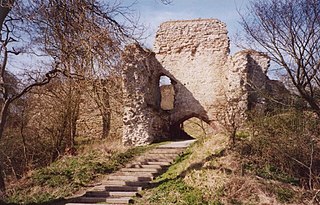
Wigmore Castle is a ruined castle about 1 km (0.62 mi) from the village of Wigmore in the northwest region of Herefordshire, England.
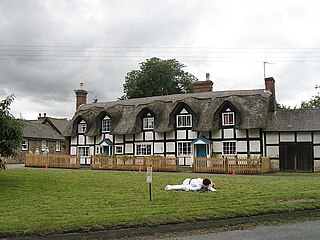
Brampton Bryan is a small village and civil parish situated in north Herefordshire, England close to the Shropshire and Welsh borders.

Welbeck Abbey in the Dukeries in North Nottinghamshire was the site of a monastery belonging to the Premonstratensian order in England and after the Dissolution of the Monasteries, a country house residence of the Dukes of Portland. It is one of four contiguous ducal estates in North Nottinghamshire and the house is a grade I listed building.

Brampton Bryan Castle is a ruined medieval castle in the small village of Brampton Bryan in north-western Herefordshire, England, 50m south of the River Teme. The castle guarded an important route from Ludlow along the Teme Valley to Knighton and on into Central Wales.

Croft Castle is a country house in the village of Croft, Herefordshire, England. Owned by the Croft family since 1085, the castle and estate passed out of their hands in the 18th century, before being repurchased by the family in 1923. In 1957 it was bequeathed to the National Trust. The castle is a Grade I listed building, and the estate is separately listed as Grade II*. The adjacent Church of St Michael is listed Grade I.
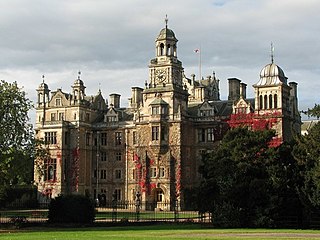
Thoresby Hall is a grade I listed 19th-century country house in Budby, Nottinghamshire, some 2 miles (4 km) north of Ollerton. It is one of four neighbouring country houses and estates in the Dukeries in north Nottinghamshire all occupied by dukes at one time during their history. The hall is constructed of rock-faced ashlar with ashlar dressings. It is built in four storeys with a square floor plan surrounding a central courtyard, nine bays wide and eight bays deep.

Sir Edward Harley was an English politician from Herefordshire. A devout Puritan who fought for Parliament in the First English Civil War, Harley belonged to the moderate Presbyterian faction, which opposed the involvement of the New Model Army in the peace negotiations that followed victory in 1646. Elected MP for Herefordshire in 1646, he was one of the Eleven Members forced into temporary exile by the army in 1647.
Edward Harley was a British Tory politician. He sat as Member of Parliament for twenty seven years supporting the group led by his brother, Robert Harley. He was also Auditor of the Imprests. Because of this, and to distinguish him from other family members of the same name, is frequently known as Auditor Harley.
Edward Harley, 3rd Earl of Oxford and Earl Mortimer was a British peer and Member of Parliament. He was the nephew of Britain's First Minister between 1710 and 1714, Robert Harley.

Earl of Oxford and Earl Mortimer was a title in the Peerage of Great Britain. It was created in 1711 for the statesman Robert Harley, with remainder, failing heirs male of his body, to those of his grandfather, Sir Robert Harley. He was made Baron Harley, of Wigmore in the County of Hereford, at the same time, also in the Peerage of Great Britain and with similar remainder as for the earldom. Harley was the eldest son of Sir Edward Harley and the grandson of the aforementioned Sir Robert Harley.
Edward Harley may refer to:

Lyonshall is a historic village and civil parish in Herefordshire, England. The civil parish includes the hamlet of Penrhos. According to the 2001 Census, the civil parish had a population of 750, increasing to 757 at the 2011 Census.
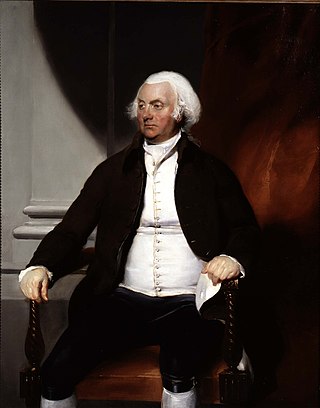
Edward Harley, 4th Earl of Oxford and Earl Mortimer,, styled Lord Harley from 1741 to 1755, was a British peer and Tory politician.

The Honourable Thomas Harley was a British politician who sat in the House of Commons for 41 years from 1761 to 1802.
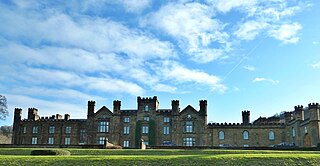
Wilton Castle is an early 19th-century mansion, built on the site of a medieval castle, now converted into residential apartments, situated at Wilton, in Redcar and Cleveland, North Yorkshire, England. It is a Grade II listed building.

Warkworth Castle is a ruined medieval castle in Warkworth in the English county of Northumberland. The village and castle occupy a loop of the River Coquet, less than a mile from England's north-east coast. When the castle was founded is uncertain: traditionally its construction has been ascribed to Prince Henry of Scotland, Earl of Northumbria, in the mid-12th century, but it may have been built by King Henry II of England when he took control of England's northern counties. Warkworth Castle was first documented in a charter of 1157–1164 when Henry II granted it to Roger fitz Richard. The timber castle was considered "feeble", and was left undefended when the Scots invaded in 1173.

Edvin Loach and Saltmarshe is a civil parish in north-east Herefordshire, England, and is approximately 15 miles (24 km) north-east from the city and county town of Hereford. The nearest town is Bromyard, 2.5 miles (4 km) to the south-west. Within the parish is a George Gilbert Scott built parish church in the virtually depopulated settlement of Edvin Loach, and the repurposed site of the demolished Saltmarshe Castle.

















